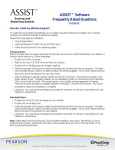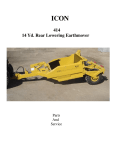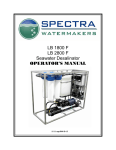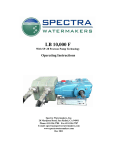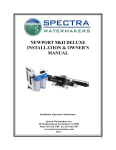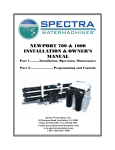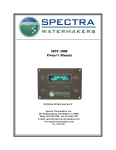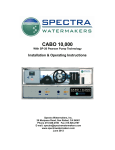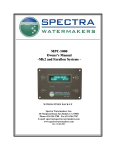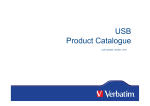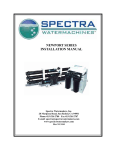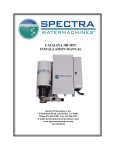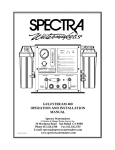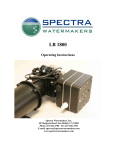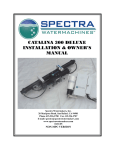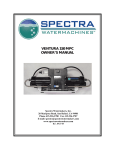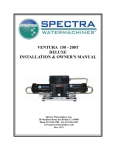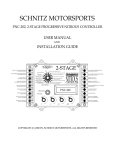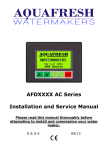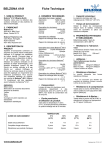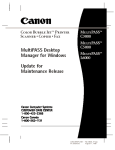Download Farallon 1800/2800 User Manual
Transcript
FARALLON 1800/2800 INSTALLATION & OWNER’S MANUAL Spectra Watermakers, Inc. 20 Mariposa Road, San Rafael, CA 94901 Phone 415-526-2780 Fax 415-526-2787 www.spectrawatermakers.com 01/12 mpc5000 B-15 2 Table of Contents Part 1 Page Number Installation Getting Started ................................................................................................................................................. 5 Installation Basics ............................................................................................................................................ 6 Component Placement ..................................................................................................................................... 7 Plumbing ........................................................................................................................................................ 10 Parker Tube Fitting Assembly Procedure ...................................................................................................... 14 Wiring ............................................................................................................................................................ 16 MPC Tank Switch Wiring and operation....................................................................................................... 20 Membrane Pressure Vessel Relocation.......................................................................................................... 38 Operation New Systems Start Up and Testing................................................................................................................21 Dry Testing.....................................................................................................................................................24 Normal Start Up Using the Auto Run ............................................................................................................25 Adjusting the Flush Cycle ..............................................................................................................................26 Automatic Store Cycle ...................................................................................................................................27 Manual Operation...........................................................................................................................................28 Maintenance ...................................................................................................................................................32 Bulletins..........................................................................................................................................................46 Service & Maintenance Long Term Storage Procedures......................................................................................................................29 Winterizing.....................................................................................................................................................31 Oil Changes ....................................................................................................................................................33 Membrane Cleaning .......................................................................................................................................34 Salinity Probe Calibration ..............................................................................................................................36 Suggested Spares............................................................................................................................................37 Troubleshooting Procedures, Service Bulletins .............................................................................................41 Part 2 Controls Begin after pg 53 3 Thank you for your purchase of a new Spectra Farallon system. When properly installed and maintained it will provide years of trouble free service. Please pay attention to the installation instructions and the system layout. Like any piece of mechanical equipment the system will require inspection and service from time to time. Do not place the components in inaccessible areas that will prevent proper maintenance. If you are having a dealer install the system for you, review the location of the components to make sure that the installation will meet your approval upon completion. Farallon Installation Quick Start Important Details for Installer 1. The system must have a dedicated sea water inlet to guarantee a solid flow of water to the system. The inlet should be as low in the boat as possible and with a forward facing scoop type thru -hull fitting installed. 2. The Spectra-Pearson Pump module must be installed in a well ventilated compartment where temperatures will not exceed 120F (48C). Many engine compartments exceed this temperature when underway. Warranty will be void if the installation does not meet this requirement. 3. Follow the wire gauge charts in the instructions! Using larger wire than specified is acceptable. 4. If you are separating the high pressure pump and membrane assembly please review the high pressure hose assembly instructions. Improper assembly will cause failure! The Control Box can also be remotely mounted, see instructions later in this manual. 5. Run, test, then “sea trial” the complete system before assuming the system is operational. If the boat is in fresh or dirty water, see “Dry testing the system.” After running make sure that the flush cycle operates properly. The water going overboard at the end of the flush should not taste salty (<1000ppm) 6. The system must have power continuously to achieve the full benefits of the fresh water flush system. The domestic fresh water pressure must be on and the fresh water tank level maintained. Calculate 15 gallons (76L) per flush.. 7. The system must be de -powered after the system is put in storage “pickled” where a storage chemical or antifreeze is run through the system. 8. Spectra dealers are responsible for educating the vessel owners on the operation and maintenance of the system. We request that you “walk through” the installation with our customer. 9. Please fill out the warranty card. The warranty is void if it is not registered. 4 Getting Started Unpack the system and inspect it to make sure that it has not been damaged in shipment. Refer to the shipping list for your system to make sure you have received all of the components listed. Do not discard any packaging until you have found and identified all of the parts. The small installation parts are listed on the cellophane bags’ pick list. We will not be held responsible for shortages that are not reported within thirty days of the ship date. Shipping damage must be reported within 30 days of receiving goods. Next, study the system layout diagram, component photos and descriptions before beginning your installation. This will assist you in understanding the function of each component. Layout the system. Before starting the installation identify the location where each module and component will be placed. Ensure that there is proper clearance around the components for removal of filters and system service. Also check to make sure you have adequate tubing and hose before starting so additional parts may be ordered. Check to see that the MPC cable is long enough to reach from the display location to the feed pump module. Farallon 1800 shipping list: Spectra-Pearson Pump Module with remote mountable Control Box Boost Pump Pre-filter Module Fresh Water Flush Module Inlet and Brine Discharge Service Modules Install Kit Service Kit 25’ 5/8” Braided Nylon Brine Discharge Hose 10’ 3/4” Spiral Wound Reinforced Suction Hose 25’ 3/4” Braided Nylon Intake Hose 25’ 1/2” Parker Product Tubing 10’ 3/8” Low Pressure Tubing 5 Installation Basics Thruhull Not Included. Read the directions! Avoid tight hose bends and excessive runs. Use heavy gauge wire. Boost Pump must be installed below waterline. Install Spectra-Pearson Pump as low and as close to the boost pump as possible. Use a dedicated thru -hull with scoop type strainer. Flow Thru-hulls It is mandatory that a minimum 1” diameter, dedicated, forward facing, scoop -type intake thru -hull and seacock be installed. Install the intake for the system as close to the middle and as far below the water line as possible. Thru-hulls in the bow area are susceptible to air intake in rough conditions. Sharing a thru -hull with another system is not acceptable and will void the warranty. Sharing a thru-hull can introduce unforeseen problems such as intermittent flow restriction, air bubbles, and contaminates. For racing boats and high speed power boats above 15 knots, a retractable snorkel -type thru -hull fitting is preferred to be able to pick up water away from the hull. Do not install the intake close to or downstream of a head discharge. Install as far below the waterline and as close to center line as possible to avoid contamination and air induction. The brine discharge through -hull should be mounted above the waterline, in or just above the boot stripe to minimize water lift. Double clamp all hose connections below the waterline. Pipe Fitting Instruction Plastic to plastic fittings should have 3 to 4 wraps of Teflon tape and will thread almost all the way in. Avoid getting dirt or debris into the piping or hoses during assembly. A small bit of debris can stop the system! Avoid getting tape over the end of fittings that might get into the system. To ensure this does not happen, leave the very first thread uncoated. Avoid restrictions or long runs on the entire inlet side of the plumbing from the thru hull to the main feed pump module. Prevent tight bends and excessive elbows. Any restrictions will hamper system performance. Secure the piping away from moving objects such as engine belts and hatches. Prevent chafe on the tubing as required. Test and inspect all piping and hose clamps after several hours of operation. Wiring Pay attention to wire size or system performance will be impaired. Perform wiring to UL, ABYC, CE or applicable standards. 6 Component Placement Refer to the Plumbing Diagrams Remote Control Panel The remote control panel can be mounted anywhere that’s dry and convenient. Cut a 4 -9/16” (116 mm) wide by 2-7/8” (73mm) high opening for the panel. Locate in an area that is easily visible and easy to manipulate the buttons. Use only Spectra approved remote cable. The cable is not standard LAN cable or phone cord. Strainer Mount the strainer in an accessible area close to the intake through hull that can handle water spillage during service. Extra care during assembly must be taken to avoid air leaks from the strainer. Use the supplied “Quick Block” and wire tie for mounting. Service Inlet Module The service inlet module is mounted between the sea strainer and the boost pump. It can be mounted in any orientation. Be sure that once installed you will have access to the yellow valve handle on top and the garden hose fitting on the side Boost Pump The boost pump module should be mounted horizontally. The boost pump, and the entire intake hose leading to it, MUST be installed below the water line to ensure that it will prime. 7 Pre-filters The Pre-filters are located between the boost pump and the High Pressure Module. They house the 20 and 5 micron filters. They should be mounted vertically so that water doesn’t pour out of the filter bowls during filter changes. Allow 2” below the filter housings for removal. Do not install over electrical equipment. Brine Discharge Service Module The brine discharge service module is mounted between the brine discharge outlet on the Spectra -Pearson Pump Module plumbing manifold and the brine discharge thru -hull fitting. It can be mounted in any orientation. Be sure that once installed you will have access to the yellow valve handle on top and the garden hose fitting on the side. Spectra-Pearson Pump and Control Module Mount the Spectra -Pearson Pump and Control Module on a horizontal surface no more than 3’ (1.0M) above the waterline. It is preferable to mount it as low as possible. Locate in an area that allows the lid to be easily lifted and is accessible for service and oil changes. Keep future maintenance in mind when choosing a location. The membranes can be damaged at ambient temperatures over 120F (48C). The Control Box can be remotely mounted if space is limited. Call the factory if an extended control cable is necessary. Charcoal Filter Housing The Charcoal Filter Housing may be located in any convenient location near the Spectra -Pearson Pump Module. It should be mounted with the filter housing vertical and accessible for changing filters. Allow 2” below the filter housing for removal. Do not install over electrical equipment. The unit contains a charcoal filter for the flush water, shut -off valve, and flush water pressure regulator. 8 Spectra-Pearson Pump Module The membrane maximum temperature specification is 120F. This module must be installed in an area that maintains a temperature below 120F (50C). A cool location is preferable. Make sure that the area around and under the pump does not have any water sensitive equipment. Water will be spilled during any repairs or if a leak occurs. Be sure you will have clearance to open the lid of the enclosure, and leave room to remove all side and top panels for easy servicing.. The Spectra-Pearson Pump Module comes complete with a mounting system. Be sure to mount the Module horizontally and securely bolt the Spectra -Pearson Pump Module to a shelf or level surface. Membrane Pressure Vessel Mounting The high pressure pump and membrane assembly has been pre -assembled at the factory. If it is necessary to disassemble this unit and mount the pressure vessels remotely use the guidelines on pg 39 of the manual. Use only approved hoses for assembly. 9 Raw Water Plumbing From the inlet thru hull through to the boost pump module use supplied clear 3/4” (19mm) spiral suction rated hose. The outlet of the Boost Pump is under pressure, use the supplied 3/4” (19mm) braided clear vinyl hose rated to 150 PSI (11 bar) from the outlet of the Boost Pump through to the high pressure pump inlet on the manifold. From the brine discharge on the plumbing manifold to the brine discharge thru -hull use supplied 5/8” (19mm) clear braided vinyl hose. Air Purge Button !! Route all hoses and tubes to prevent kinks and restrictions. Secure piping away from moving objects such as engine belts and hatches. Prevent chafe on tubing as required. Test and inspect all piping and hose clamps after several hours of operation. 10 System Piping schematic Fresh Water out to tanks. Use supplied 1/2” black Parker tubing. Brine Service Module Air Purge Button Brine Discharge—Use 5/8” braided hose from the manifold through the Brine Discharge Service Valve and to the brine discharge thru-hull Use the 3/8” nylon tubing between the Flush module and the High Pressure Pump Module Air Purge Button From the Boost Pump through the 20 micron filter inlet out to the plumbing manifold use the 3/4 inch braided hose. Flush water from ship’s pressure water system 25 psi (2bar) minimum Inlet Service Module 20micron 5 micron From the inlet thru-hull up to the boost pump module use the supplied clear 3/4 (19mm) spiral suction rated hose. 11 Note! When plumbing the Farallon High Pressure Module route the feed water so that the top and side covers may be opened without removing the hoses or tubing. Leave room on this side for attaching tubing and accessing the pump, motor and diversion valve. Fresh Water Flush Inlet—In from the Fresh Water Flush Module Feed Water Inlet—From boost pump Product Water Outlet—To Ship’s Tanks Brine Discharge—To above the waterline Thru-Hull 12 Product Water tubing Product water tubing is 1/2” (9.5mm) Parker tubing. See the Parker tube fitting assembly diagram on pg 14. Product water goes from the membrane into the pump module manifold where it passes through the flow meter, the salinity probe and the diversion valve. If the salinity is good the diversion valve energizes and the product goes to the tank from the manifold product outlet. If the diversion valve is not energized the product goes back into the feed water. Route the product water tube from the product water outlet fitting on the High Pressure Module manifold into the top of the tank. Install a tee in the water tank fill or tap a pipe thread into an inspection port in the top of the tank. Do not feed the water into a manifold or bottom of the tank. Make sure there is no restriction in this plumbing. A product sampling tap can be installed along the tank fill hose between the manifold and the tank connection. If a sampling tap or filling manifold is to be installed on the product water line, then an “open -before-close” type 3 way valve should be used to ensure that the product water line is never accidentally pressurized. If the length of product water tubing supplied with the watermaker is insufficient, use a larger size hose. Product water flow restriction will cause reduced output and increased power consumption and can potentially damage the membrane. 1/2” Parker Tubing— Product to Fresh Water Tank 13 Parker Tube Fitting Assembly Procedure Spacer Single grab ring for 1/4" & 3/8" tube Use 2 grab rings for 1/2" tube O-ring Body Nut Tubing Step 1: Dissemble fitting components 1/2" max Step 2: Install the Nut first then use the bevelled side of the Spacer to push the Grab Ring onto the tube no more than 1/2". Slip the O-ring over the tube to hold the Spacer in place. If the Grab Ring is pushed too far, trim back the tube so about 1/4" of tube extends past the O-ring. Step 3: Gently fit the tube into the body and loosely thread on the nut. Be careful not to cross-thread the nut 1/2" tube should not bottom out in the fitting to allow full compression of the O-ring Step 4: Hand tighten the nut. DO NOT OVER TIGHTEN! DO NOT USE A WRENCH! The tube should not come out if pulled by hand. If it does, tighten the grab ring tabs. 1/4", 3/8", 1/2" Parker Tube Fitting Assembly 14 Brine Discharge Route the Brine discharge from hose barb fitting to a location above the waterline using the supplied 5/8” braided nylon hose. Fresh Water Flush Run a feed line from the domestic cold water pressure system to the 1/2 hose barb on the fresh water flush assembly. This needs to be pressurized even when the boat is unattended for the fresh water flush system to function properly. The domestic fresh water pump must be able to deliver 2 gallons per minute (7.5lpm) at 25 PSI (1.5Bar). Air Purge Button To Flush water Inlet on pump module manifold Fresh water from boat’s pressure water system 15 Wiring PROVIDE CIRCUIT PROTECTION AT THE SOURCE!! Inadequate wiring will cause a loss of system performance and could be a fire and/or shock hazard. Wire Sizing Farallon 1800 110V: Use a 15Amp breaker and 12 AWG wire for 10.5 Amperes. 220V use a 10 Amp breaker and 12 AWG wire for 5.5 Amperes. All systems require a 10 Amp breaker or fuse on the DC bus for continuous DC power to the MPC control board. Amperage ratings assume a Pf of 60%. Actual measurements may vary. Farallon 2800 220V use a 15 Amp breaker and 12 AWG wire for 7 Amperes. All systems require a 10 Amp breaker or fuse on the DC bus for continuous DC power to the MPC control board. Amperage ratings assume a Pf of 60%. Actual measurements may vary. DC power must be supplied to the MPC control system. This will allow the unit to retain its fresh water flush timer interval when no AC power source is present. This should be sized for a 10 Amp maximum current and all DC conductors should be sized and routed according to ABYC, Marine UL or CE standards. Consult the factory if DC power is unavailable. Note: If the specified circuit breaker sizes are unavailable use the next higher rating but do not exceed the specification by more then 10%. All wiring to be done to applicable ABYC, Marine UL or CE standards. 16 WIRING Make sure that the Control Box is mounted in cool dry place, well above bilge level and not subject to water spray. Connect the remote display cable to the open display jack on the side of the electrical box. Route the remote display control cable through the boat to the MPC remote display location. Be careful not to damage the connector or get it wet. Plug this into the back of the remote display. Display Jacks Batt + Batt - Backup Battery Connect DC power to the Batt + and Batt - posts on the MPC board, pictured above. DC power feeds should be sized for 10 Amp maximum supply and be uninterruptible to insure proper operation of the auto store feature. Avoid house breaker panels that could be easily tripped. Connect the DC power cables directly to the battery positive and negative posts on the MPC board. Route the boost pump power cable to the Control Box from the boost pump. Do not get the cable wet, and be careful not to damage the plug or conductors during installation. The boost pump power cable plug is located inside the Spectra-Pearson Pump Module on the wall near the top of the motor. Be sure to plug the boost pump into the corresponding socket on the Control Box. Boost Pump Plug 17 MPC Remote Control Display Panels There are currently two types of display options available: Liquid Crystal Diode (LCD) display, which is dark lettering on a backlit background, or Vacuum Florescent Display (VFD), which are bright characters on a dark background. The VFD display brightness can be adjusted using the Programming Function detailed in Part 2 of this manual. The displays must be mounted in a protected location, out of direct sunlight, and away from spray or dripping water. Commands to the system can be entered at any panel. The display panels connect with the supplied 75 foot modular -type cable to the MPC board sockets marked “DISPLAYS.” Do not substitute a different type of cable! Contact the factory if you need longer or additional cables. 3 3/4” (9.5cm) 5 1/4” (13.3cm) 18 Connection of Optional Accessories Use of any external devices not approved by the factory may cause permanent damage to the controller and is not covered by the Spectra warranty. Accessory outputs are limited to 2 amps maximum load! Do not connect motors, pumps, etc to accessory outputs. Ultraviolet Sterilizer: Detailed instructions are included with the sterilizer kit. The UV sterilizer lamp module and ballast unit should mount vertically, with the product water inlet at the bottom, outlet at the top. The ballast wires plug into the end of the bulb in the lamp module. The ballast RED wire connects to “STER” terminal on the MPC board, and the ballast BLACK wire connects to the “GND” terminal. If the wires must be extended, use minimum 16AWG wire. External Buzzer(s): In addition to the external buzzer(s) installed at each remote control display panel, a buzzer unit may be installed at the control box. The buzzer RED wire connects to the “BUZZ” terminal on the MPC board, and the buzzer BLACK wire connects to “GND.” Float Switches: The Spectra Farallon can have optional tank float switches installed for complete automated operation. See detailed instruction on pg 20 for operation and installation guidelines. 19 Tank Switch Installation and Operation: There are two sets of terminals on the MPC -5000 PCB that can be used in four different configurations to automatically start and stop the watermaker, or to automatically stop the watermaker when the tank(s) are full without the auto start feature. These terminals are on the green ten pin connector on the MPC board and are labeled “Float Switch 1” and “Float Switch 2.” Float Switch 1 is the tank full switch and Float Switch 2 is the tank empty switch. If the unit is wired for both Auto Start and Auto Stop, it can be put into Auto Fill Mode by pushing and holding the Auto Run switch on the MPC -5000 display. In this mode the watermaker will start whenever the water level drops below the tank empty switch, so that it is open (not conducting electricity). When the tank fills up and both the tank full switch and the tank empty switch have remained closed for 2 minutes, the watermaker will shut down and flush itself. The water maker will start back up when the water level drops below the tank empty switch and it remains open for 2 minutes. This configuration allows for completely automatic operation. If the watermaker does not need to start up within five days it will automatically do a fresh water flush. Auto Fill mode can be ended by pushing the stop button or the Auto Store button. If the watermaker is in Auto Run mode it can be put into Auto Fill mode without stopping it by holding down the Auto Run button. If the owner prefers to install the automatic shutoff feature without the automatic start up option, only the tank full switch is used. A jumper must be placed between the tank empty terminals (Float switch 2) in place of the tank empty switch, because the watermaker will only shut down if both sets of terminals are closed. To use this mode the watermaker must be started up with the Auto Fill mode. The watermaker will fill the tank and automatically enter Auto Store mode. It is possible to use the auto fill feature with 2 tanks. A double throw electrical switch must be installed in a convenient location. If only the single tank full switch is installed in each tank connect the wire from the ‘Float Switch 1’ terminal “1” to the common on the switch and run separate wires from the switch to each tank switch. The second wires can both be run to the Float Switch 1 terminal 2. If you are using two switches in each tank you will need a double pole double throw switch. See wiring schematics beginning on pg. 45 for detailed drawings. 20 New System Start-Up and Testing Use this procedure when starting a new watermaker for the first time, when the last known state of the system is unknown, or whenever the system contains Preservative or cleaning compounds. Test the machine after installation to ensure proper operation!! Avoid running the system if the vessel is in contaminated water, such as in a dirty harbor or canal, however, it is preferable to sacrifice a filter by running the system in turbid water rather than waiting to get offshore to discover a problem or deficiency in the installation. The system should be fully run tested before leaving port. If the location or weather prevents proper testing refer to the section “Dry Testing.” Warning! Damage may occur if the purge sequence is bypassed and the membrane is pressurized with storage chemical in it. 1. First Check That: Thru-hull valve is open Run Manual/ Run Auto/ Flush Manual Switches are in “Run Auto” Position Domestic fresh water pressure system must be on Replace Sealed Oil Cap with supplied VENTED OIL CAP prior to running machine Oil Cap 2. Open pressure relief valve 1 turn ! 3. Turn on AC and DC power to the system to enter “Purge Mode”. Note: The watermaker will not run with the pressure relief valve open unless it is in “Purge Mode”. Instead it will restart twice and then alarm “System Stalled”. Alarm will sound Display will read “Open Pressure Relief Now” Ensure that it is open. Push the Alarm /Display button to silence alarm 21 4. Press Auto Run Button The system will go into a start mode and the Spectra -Pearson Pump will start shortly after. The system should prime within 60 -90 seconds. Check the strainer and the brine discharge for water flow. There should be no bubbles anywhere in the intake hoses and the Spectra -Pearson Pump should sound smooth after priming. If it continues to sound rough, find the reason before continuing! Inspect the system for leaks. If the system continually alarms ‘Service Prefilter’ at the beginning of the purge sequence, then air may be trapped in the prefilter housings. Use the ‘Air Purge Button’ on top of the filter housings to evacuate the trapped air, and try again. Note: If you must stop the purge sequence for any reason, the control will default back to the beginning of the purging mode to protect your system. If you wish you can bypass the purge sequence and initiate a normal start. Pressing both “ Auto Run” and “ Stop” simultaneously anytime during the purge sequence will bypass the purge sequence and enable a normal start. Do not bypass the purge mode unless you are certain that no storage or cleaning chemicals are present in the system. Do not pressurize the system for the first twenty minutes or more. Make sure that you have purged the system adequately or you will damage the membrane. 5. After the purge sequence. The control will alarm with the message “Close pressure relief valve” - Close the pressure relief valve and proceed by pressing “ Auto Run.” 6. The system is now running under pressure and making water. The display will read “purging product water.” This mode sends the product water overboard for ten minutes in case there are any residual chemicals in the membrane. Carefully inspect for leaks over the entire system! Shut down the system and repair any leaks you find. 7. The system is now in the operational mode. You may start and run your system as you desire. You will not have to go through the purging mode unless you shut -off power to the system. If you do, you can bypass the purging mode by pushing “Stop” and “Auto run” buttons at the same time. It is best to use the “ Auto-Run” and “ Auto-Store” button to start and stop the machine. If you shut down the system using the “ Stop” button, then press the “auto store” button to do a fresh water flush cycle. 8. Check that the system is operating within its normal parameters. Compare with the chart on the next page. Be sure to remove the paper battery isolating tab on the MPC battery backup after completing the purge sequence. 22 Product Flow Farallon 1800 Will produce 74 - 76 GPH (280-293LPH) Farallon 2800 Will produce 115 - 117 GPH (435 - 443LPH) NOTE: To toggle between US standard and Metric Units access the program mode as described in section 2 of this manual. Salinity Salinity reads in parts per million. System rejects water higher than 750 PPM. Anything below 500 is excellent. Membrane Pressure Membrane pressure will vary depending on feed water conditions. Normal operation will see pressures between 600 and 800 psi. At no time should membrane pressure exceed 900psi. Filter Condition PREFILTER warns that filters are getting dirty. Clean filters as soon as convenient. If the graph reaches full scale the machine will automatically slow down to Run Low speed. If it reaches full scale again it will alarm Service Prefilters and shut off the watermaker. The number in the top right corner represents Boost Pressure from the Boost Pump. As boost pressure drops, more boxes will fill in, indicating clogged filters. 23 Dry Testing With Artificial Ocean If it is not possible to test run the system with the boat in the water testing may be accomplished with an artificial ocean. Purchase enough salt to make 5 gallons (20 liters) of salt water. Salt water is 32,000mg/L or 3% salt by weight. Make sure that the domestic water system is powered up and that there is water in the tank. Confirm that the Charcoal filter is installed in the Fresh water flush module and that the domestic water line has been installed and all valves are open. 1. 2. 3. 4. Open Pressure Relief Valve. Power up the control system. Close the sea cock Press both “ Auto Run” and “ Stop” to bypass the purge sequence. If the motor starts, stop immediately and press the Auto run and stop buttons again until you get the message PURGE MODE BYPASSED. 5. Press the “Auto Store” button and allow the fresh water flush system to cycle through its timed operation. Press the “auto store” system 5 or more times to purge all of the storage chemicals out of the system (20 minutes total purging). If the Spectra -Pearson Pump is cavitating during the flush cycle, then there isn’t enough flow to the pump. See the instructions for “Flush Cycle Adjustment”. 6. Hook up your service hoses to the Brine Discharge Service valve and the Service Intake Module. Route them into a 5 gallon (20 Liter) bucket. 7. Turn the yellow valve on the Service Intake Module from “ Run” to “Service.” 8. Press auto flush one more time to fill the bucket, press “Stop” once the bucket is nearly full. Add 32grams of salt for every liter of water in the bucket to approximate the salinity of an ocean. If you have a hydrometer, mix salt into the bucket until you have specific gravity of 1.024. 9. Close the pressure relief valve and start the system using the “ Auto Run” Button. If you have no way to measure the salinity, slowly add salt while running the machine until the membrane pressure reaches 650psi (45bar). 9. Run and test the system for as long as possible. During the run test carefully inspect for leaks. Check all of the system parameters to make sure the system is operating correctly. Do not allow the water in the bucket to get above 120F (50C). 10. Store the system per the “Storage” instructions. 24 Normal Start Up Using the Auto Run Button If the system contains preservative or cleaning chemicals follow the directions for New System Startup or membrane damage will occur! Press Auto Run button once and the system will prime and run for 1 hour. The display reads “AUTO RUN MODE —1:01” then “STARTING” with a 10 second priming countdown. Each time you tap the “Auto Run” button an hour of run time is added, up to a total of 12 hours. An additional hour can be added at any time during the run cycle. Pressing the Alarm/Display button will scroll through the system data. When the run timer reaches the end of its sequence the system will automatically fresh water flush for the designated amount of time. At the end of the flush cycle the system will automatically begin the 5 -day fresh water flush countdown. The system will fresh water flush itself every 5 days indefinitely. Pressing the Stop button stops the system, regardless of mode of operation, at any time with no flushes. The system can be re -started from any mode by pressing the “Auto Run” button, and the sequence above will start all over again For optimum performance, run the system as long as possible at one time using the “Auto Run” feature. Never let the system sit with salt water in it. Never allow air leaks in the intake, these can damage the Spectra -Pearson Pump. Normal Shut Down If the system was started using the “Auto Run” button, the system will shut off on its own when the selected run time is over and will automatically fresh water flush every 5 days. Pressing the Stop button at any time will shut off the system with no automated flush. If the Auto Run Cycle was stopped before the timer ran out then immediately press the “Auto Store” button to initiate the fresh water flush sequence. At the end of the flush cycle the system will automatically begin the 5 -day fresh water flush countdown. The system will fresh water flush itself every 5 days indefinitely. Note: Periodically Check all plumbing connections for leaks, including the oil pump and filter assembly. 25 Flush Cycle Adjustment Before shipping from the factory the Farallon watermaker flush cycle is adjusted to factory default settings. After initial start up, and annually thereafter, the flush cycle should be checked. The water going overboard at the end of the flush cycle should not taste salty ( <1000ppm). If the water at the end of the flush is still salty, or to minimize the amount of fresh water used during the flush cycle, follow these instructions to optimize the cycle. First adjust the flush water pressure regulator. Remove the 3/8 inch Parker Tubing where it attaches to the flush water inlet fitting on the manifold at the Spectra Pearson Pump module. Push the Auto store button. Water will begin to flow out of the flush water tube. Using a graduated container, allow the water to flow into the container for exactly thirty seconds, then push the stop button. If more than 4 quarts (4 liters) of water went into the bucket the pressure regulator is set too high, if less the 3 quarts (3L) flow into the bucket the pressure is too low. Adjust the regulator by loosening the lock nut and turning the adjusting screw. Test again until the correct flow is achieved. Reconnect the fresh water flush hose. Pressure regulator Next adjust the Flush Duration. Follow the instructions in section 2 of this manual to access the program mode from the remote display. Scroll through the menus until you reach the display titled ‘Flush Duration’. This is set to a factory default of 7 minutes and can be increased or decreased by whole minute values only. If the system requires less water for a fresh water flush, then this number can be decreased. If the membranes are not completely flushed at the end of the factory default flush cycle then this number should be increased until the brine discharge salinity is within acceptable limits. After setting the ‘Flush Duration’, scroll to the ‘Pump On Time’ menu. This is set at a factory default of 360 seconds, and should only be adjusted in increments of 60 seconds. If you increased the flush time in the step above, then you MUST increase the ‘Pump On Time’ accordingly. An increase of 1 minute in the flush duration will require the ‘Pump On Time’ to be increased by 60 seconds. If the system required more water to properly flush the membranes, then increase the ’Pump On Time’ value to 420 seconds, if the system required less water, then decrease the value to 300 seconds . Run the machine for 10 minutes, then perform a fresh water flush and test the brine discharge after each time you change the value to see if the you have achieved the desired affect. See the formula below for the relationship between ‘Flush Duration’ and ‘Pump On’ and ‘Pump Off Time’. Flush Duration in minutes X 60 = Pump On Time + (Pump Off Time X 2) Flush Duration = 7 Pump On Time = 360 Pump Off Time = 30 7 X 60 = 360 + (30 X 2) 420 = 420 Note: If after adjusting the fresh water flush regulator and the Flush Duration the flush cycle is still not operating properly, please contact the factory for further instructions. Ex: 26 Automatic Store Cycle Warning! Proper understanding of the Spectra flush system and the vessel’s fresh water system configuration is mandatory for extended Auto Store cycles. The flush cycles must not be allowed to drain all the fresh water from the vessel or damage to the vessel’s systems and the watermaker may occur. Make sure there is enough water in the fresh water supply system to supply the watermaker for more than the expected time of operation in the “re -flush every 5 days” mode. The Farallon units require about 15 gallons (57 liters) every 5 days. Make sure that the pressure water supply is on and will stay on during the flush mode (If this is not possible contact your certified dealer.). Make sure that the pressure relief valve is closed. It should be closed if the system was just used to make water. The auto flush may not operate if the valve is open. The power for the system, AC and DC, must remain on during the auto flush mode. Turning off the power will disable the auto store function and damage may occur. Pressing the Auto Store button momentarily will start a flush and then activate the 5 day flush cycle. The flush water solenoid will open and the display will read “FRESH WATER FLUSH” with a countdown timer. After 60 seconds the Spectra -Pearson Pump will start, after 6 minutes the pump will stop while the flush valve remains open for another 60 seconds. Them the display will read “FLUSH TIMER INTERVAL”, and the countdown timer will reflect the number of hours until the next flush. Pressing and holding the Auto Store button for 3 seconds will engage a 1 time flush. The system flushes as described above but will not re-flush every 5 days. Display will read “FRESH WATER FLUSH” with a countdown timer, then the default display when finished. Pressing the “Stop” button will cancel the auto store mode and put the watermaker in standby mode. 27 Manual Operation In the event of a component failure resulting in a shut down due to a false alarm, the failed component can be overridden using the Programming Function on the display. High Pressure, Service Prefilter, System Stalled (airlock), and Salinity Probe Failed can be defeated. If one safety shutdown is disabled, the other safety shutdowns will still be activated. The pressure sensors and salinity probe can also be calibrated from the display. Complete instructions are found in Part 2 of this manual under “Programming from the Display”. Be absolutely certain that the alarm is false before defeating the automatic controls. In the event of complete MPC control failure, the system may be operated manually by using the manual run switch on the Electrical Box and manually opening the diversion valve. For manual start up, switch on the Spectra -Pearson Pump and Boost Pump by setting the feed pump switch to “RUN MAN”. Shut the unit down if the Spectra -Pearson Pump knocks loudly or sounds rough or if air is continuously present in the intake line. The automatic safety controls are disabled in manual mode. The diversion valve, an electrically operated three way valve which is normally energized by the MPC controls to send water to the tank, will not open automatically in manual mode. Instead, it must be opened using the mechanical override button on the valve. The button is located on the side of the valve opposite the electrical connection and above the plumbing fittings. Firmly press the button in as far as it will go and rotate it 90 degrees Clockwise. This locks the diversion valve open. Always discard the product water for the first few minutes of operation. The initial product water from the system may not be potable. Taste the product water before sending to a tank. To get a water sample loosen the 1/2 inch product tube fitting at the diversion valve in the High Pressure Module or remove the tubing from the membrane outlet and collect a sample, or collect a sample of a sampling tap—if installed. Check it with a handheld salinity meter or taste it. Run Manual Toggle Switch Diversion Valve Diversion Valve Manual Bypass 28 Long Term Storage Procedures Watermakers are best run continuously. When not in use, biological growth in the membrane is the leading cause of membrane fouling. A warm environment will cause more growth than a cold environment. The auto fresh water flush system will greatly reduce biological growth but may not stop it completely in certain conditions. The 5 day auto flush feature allows the system to be left without any service procedures for extended periods of time but it doesn't replace performing a storage procedure for long periods of non -use. System Storage or “Pickling” If the system is to be left unused for more than 2 weeks, perform the following storage procedure. The procedure introduces a chemical compound into the system that prevents biological growth. This procedure requires de-chlorinated water which can be made with the Spectra’s charcoal filter. Charcoal filters last a maximum of 6 months once wetted. Spectra SC-1 is a special storage compound used by the US Navy. It is formulated to be compatible with the modern engineering plastics and composites in the Spectra pumps. Do not use any substitute except propylene Glycol, SC-1 Storage Compound has to be mixed at a ratio of 1 Spectra container to 3 gallons (12L) of fresh water to have the proper solution. An average of 4 gallons (11L) of water is in a Farallon system. This water has to be figured in to the mixture. A Farallon system uses two SC-1 containers. Caution! Avoid contact with skin, eyes, or lungs with the storage chemical. 29 Storage Procedure: Step 1: Push the “Auto Flush” button on the MPC -5000 display, when the first flush has been completed, press “Stop” to cancel the 5 day interval timer, then press “Auto Flush” again. Step 2: Install the 5/8” braided nylon service hose from the service kit on the three -way valve installed on the brine discharge outlet, and lead the hose to a 5 gallon bucket. Turn the valve handle to the ‘Service’ position. Step 3: Push the “Auto Store button: to fill the bucket with 2 gallons of fresh unchlorinated water. When the bucket has reached the desired level Push the “Stop” button Step 4: Connect the hose, using the garden hose barb fitting from your service kit, to the service port of the Service Intake Module. Lead the hose into the same bucket. Turn the service valve on the boost pump module 180° to the ‘Service’ position, so the intake is now coming from the bucket. Step 5: Mix the storage chemical compound into the water in the bucket. Step 6: Make sure the pressure relief valve on the Spectra -Pearson Pump is Open (unpressurized). Pressure Relief Valve Step 7: Set the switch on the pump module to “Service System” to turn on the feed pump and boost pump. Circulate the storage chemical in the system for approximately 20 minutes. Set the switch to “Run Auto” when finished. Clean Up: Remove the brine discharge service hose from the three -way valve, and turn the valve back to the ‘Run’ position. You may at this point, if you choose to, pump the bucket dry by using the feed pump switch. Stop when the bucket is empty. Turn the service valve 180° back to its original ‘Run’ position, remove the service hose, and replace the dust cap. Turn off the AC and DC power to the system. LEAVE THE PRESSURE RELIEF VALVE OPEN 30 Storage & Winterizing Warning! Use only potable water antifreeze (Propylene Glycol). Do not use automotive antifreeze (Ethylene Glycol). Propylene Glycol is an effective biocide and antifreeze only at concentrations above 25%. Commercially available products range from 25 to 60 percent. They are usually labeled with a temperature rating. “Minus 50” antifreeze is already diluted to 25%. “Minus 100” is a 60% solution. Purchase the strongest antifreeze available. Use enough to ensure that the system contains at least a 25% solution even after dilution with the residual water inside the watermaker. Step 1: Flush the system twice. Push the “Auto Flush” button on the MPC -5000 display, when the first flush has been completed, press “Stop” to cancel the 5 day interval timer, then press “Auto Flush” again. Step 2: Open pressure relief valve on the Spectra-Pearson Pump. Step 3: Pour the propylene glycol into a bucket. Follow the instructions on the container. Step 4: Connect the intake service hose to the service port of the Intake Service Module. Lead the hose into the bucket. Turn the service valve on the Intake Service Module 180°, so the intake is now coming from the bucket. Step 5: Set the switch on the Electrical Box to “Service System” to turn on the Spectra Pearson Pump. Pump as much of the water remaining inside the water maker overboard as possible. Run the feed pump until you see antifreeze begin to appear in the brine overboard hose. Set the switch to “Run Auto” to stop the Spectra -Pearson Pump. Step 6: Attach the brine discharge service hose from your service kit, to the Brine Discharge Service Module and lead the hose to the bucket. Step 7: Set the switch to “Service System” to circulate the antifreeze for about 20 minutes. Clean Up: You may at this point pump the bucket dry by using the feed pump switch and turning the brine discharge service valve back to the run position. Stop when the bucket is empty. Remove the service hoses from the Intake Service and Brine Discharge Service Modules and return the valves to the run positions. Turn off the power to the system and the MPC control. LEAVE THE PRESSURE RELIEF VALVE ON THE SPECTRA -PEARSON PUMP OPEN. 31 Maintenance General Periodically inspect the entire system for leakage and chafe on the tubing and hoses. Repair any leaks you find as soon as practical. Some crystal formation around the Spectra -Pearson Pump blocks is normal. Wipe down any salt encrusted areas with a damp cloth. The Seawater Strainer The sea water strainer’s stainless steel element should be inspected, removed, and cleaned as needed. A clogged strainer will cause the MPC control to alarm “Service Prefilters” Be careful to ensure that the thru -hull is closed before disassembly and the seal and element are in place before reassembly. Put the screen up to a light for inspection. When the system is put into storage, remove, rinse, and reassemble dry to impede corrosion. Check frequently during operation. The Prefilters Service the prefilters as soon as possible after the prefilter condition graph begins to rise. If the filter condition graph gets all the way to “Replace” the machine will slow down. When display reaches “Replace” a second time the alarm sounds and the system will shut down to prevent damage. To service the filters shut off the thru -hull, open the housings, discard the old filters, Clean out the housing bowls, reassemble the housings with new 20 and 5 micron filter elements. The 5 micron filter goes downstream from the 20 micron. Leave dry until next startup. Use only Spectra approved filters or you may void your warranty. Occasionally, lightly lube the O -rings with silicone grease. The Charcoal Fresh Water Flush Filter Replace the charcoal filter element at least every 6 months. 32 MAINTENANCE GEARCASE LUBE OIL Use only 5W-30 synthetic oil in Spectra-Pearson Pump crankcase. Do not overfill the crankcase with oil. Check oil condition and level frequently. The Oil, Filter, and Pump assembly should be replaced every 5000 hours or annually, whichever comes first. The Spectra– Pearson Pump comes mounted on a counterclockwise rotating Giant ™ crankcase with integrated oil pump and filter. This system is designed for easy maintenance with long intervals between required oil changes. Inspect the oil level and condition often. The oil in the crankcase should be changed every 5,000 hours or when the oil appears milky. There is an inspection window that is visible from the plumbing manifold side of the Spectra Pearson Pump, or the oil can be check by the vented dipstick on the top of the crankcase. Oil Pump Outlet Tube Oil Filter Oil Pump Oil Change Button Vented Oil Cap Inspection Window CHANGING THE OIL 1. Place a container in or near the Spectra -Pearson Pump Module that can hold up to 2 pints of liquid. 2. Disconnect the Oil Pump Outlet tube from the filter and lead it to the container. 3. With DC power to the Control Box on, press the Oil Change Button on the top of the crankcase. 4. Run the small oil pump manually until no more oil comes out of the tube. 5. Replace the filter with new, p/n FT-FTC-1/4FLFD, and reconnect tubing, and plug. See instructions included with oil change kit for more detail. 6. Using a small funnel fill the crankcase with oil until the level reaches the halfway point on the inspection window, or the marked line on the dipstick. Run the oil pump to fill the filter with oil and add oil until the oil is at the correct level. Replace the vented dipstick. 33 The Membranes The membranes need to be cleaned only when operating pressures have risen more than 10% or the product quality degrades. The leading cause of fouling in marine use is from biological growth that occurs when the system is left unused without flushing or pickling. Fouling from mineral scaling can happen during operation under certain sea water conditions, and from rust. Monitor the product salinity and membrane pressure for higher than normal readings for the conditions. Other conditions can cause high pressure such as cold water or high ocean salinity. Low product flow is usually due to blocked or partially blocked pre-filters, Spectra-Pearson Pump problems, or low boost pressure. Look for all other causes before cleaning the membrane. Membrane life can be shortened by excessive cleaning. There are two types of cleaners: acid and alkaline. The acid cleaner (SC-3) will remove mineral scaling. The alkaline cleaner (SC-2) is used to remove biological by-products, oil, and dirt particles that get past the prefilters. If membrane performance is reduced and they have not been pickled recently, cleaning with both chemicals is recommended. The acid cleaner should be used first. If the membrane fails to respond to both cleanings, this is an indication of another problem with the system, or that it is time to replace the membranes. Contact Spectra Watermakers before removing a membrane. Membrane Cleaning For normal cleaning, the SC -3 Acid Cleaning Compound is used first, then the SC -2 Alkaline Cleaning Compound. If known bio -fouling is present, the SC-2 may be used first. Use hot water if possible, up to 120°F (45C) is recommended as it greatly enhances the ability of the cleaners to do their jobs. If the history of the system is unknown or has been left “unpickled” for an extended length of time and biological growth is present, it is recommended that the system is cleaned with SC -2, using an alternate source of unchlorinated fresh water before the system is run under pressure. A simple test can be performed to see if biological growth has occurred. Before running the system, remove the prefilters and examine their condition. If the housings are full of smelly discolored water, the system was not properly stored. Install clean prefilters if they were bad. Next check the membrane. Attach the brine discharge service hose and lead to a bucket. Open the pressure relief valve one turn, and manually run the system for 30 seconds. Examine the brine water: if it’s discolored and smells bad, perform an SC-2 cleaning with an alternate source of unchlorinated water before running the system pressurized. If the brine is fairly clean, the system can be purged, run normally, and checked for performance. Clean the membranes only if performance is reduced. Heating the water is preferable. One way to do this is to find a camp stove and use a large stainless steel pot to heat the solution in. The cleaning solution throughout the system will heat as it circulates in and out of the pot. An alternative is to heat the one or two gallons of water to 120° on the before mixing in the cleaner and circulating it into the system. Periodically stop and reheat the solution. Perform the cleaning procedures while the ship is in acceptable sea water for purging and testing. 34 Note: Procedures are the same for the SC-2 and SC-3 cleaners Warning! The pressure relief valve on the Spectra-Pearson Pump must be open for this procedure or membrane damage may result. Maximum pressure 50 psi. A Spectra Cleaning Compound (SC-2 or SC-3) must be mixed with fresh water at a ratio of 1 container of compound to 3 gallons (12L) of unchlorinated water to have the proper solution. An average of four gallons (8L) of water is already present inside a Farallon system . This water has to be figured into the mixture. A Farallon system will use 2 containers of compound. SC -2 and SC-3 are never mixed together. Do not use them for storage pickling solution. Cleaning Procedure: Step 1: Close the seacock. Flush the system twice. Use the “Auto Flush” button on the MPC-5000 display, once the first flush has been completed, press “Stop” to cancel the 5 day interval timer, then press “Auto Flush” again. Step 2: Connect the brine discharge service hose to the Service Port on the Brine Discharge Service Module, turn the yellow handled service valve to the Service position , and lead the hose to a bucket. Step 3: Press “Auto Flush” again to fill the bucket with 2 gallons (8L) of fresh unchlorinated water. Press “Stop” when the bucket has reached the desired level. Step 4: Connect the intake service hose, using the garden hose barb fitting from your service kit, to the service port of the Intake Service Module. Lead the hose into the same bucket as the brine discharge service hose. Turn the service valve on the Intake Service Module 180°, so the intake is now coming from the bucket. Step 5: Mix the cleaning chemical compound into the water in the bucket. Note that not all of the chemical will dissolve completely into solution. This is acceptable and will not harm the system. Step 6: OPEN THE PRESSURE RELIEF VALVE ON THE SPECTRA-PEARSON PUMP. Step 7: Use the “Run Manual” switch on the MPC control box to turn on the feed pump. Circulate the storage chemical in the system for approximately 25 minutes. Allow to soak for several hours or overnight if the solution is cold. Run the pump occasionally to agitate the solution. Set the toggle switch to ‘Run Auto’ when finished. Step 8: Replace the brine overboard hose . Remove the Inlet Service hose and turn the Service valve to the Run position . Step 9: To avoid damaging the membranes, Follow the “New System Startup” Instructionsto Purge the chemicals out of the System. 35 Salinity Probe Calibration Salinity is a measurement of dissolved solids in liquid: these solids will conduct electricity to varying degrees. A special probe is used, with two electrical contacts in it, to determine the resistance to the flow of electricity in the liquid. The higher the resistance, the lower the PPM of dissolved solids. In the Farallon systems, the salinity probe is located in a port on the bottom of the pump module manifold. This way we can look at the salinity level of the product water before deciding to either reject the water or accept it and divert it into the holding tank. The salinity level in parts-per-million can be seen through the remote display. Using a hand -held tester, note the salinity in parts per million (ppm) of your product water after the unit has been running, be sure to calibrate the hand -held salinity meter as per the manufacturer’s instructions. The salinity circuit can be adjusted from the display in the Salinity Cal window, or from Spectra software by adjusting the “Salinity Calibration” parameter. Increase the calibration parameter to increase the salinity reading. Follow the programming instructions in the second section of this manual for more detail on adjusting the parameters. Cleaning the Salinity Probe To remove the salinity probe for cleaning, use a wrench to unscrew the probe from the manifold. Be careful not to put too much strain on the attached cable while unscrewing the probe from the manifold. Use emery cloth or very light grit sandpaper to gently clean the probes inside the white housing. Upon re -installation, it is necessary to use Teflon tape on the salinity probe threads before re-installing to prevent leaks, again use caution when tightening the probe so as not to damage the cable. 36 Suggested Spares Short term cruising, weekends etc. We suggest a hand held salinity meter and basic cruise kit. Kit consists of 3 ea, 20micron, and 5 micron filters and two SC-1 storage chemicals. Cruising 2 to 6 months at a time. Two basic cruise kits, One each replacement charcoal filter, Oil Change Kit, Salinity Probe. Longer than 6 months, Additional filters, membrane cleaning chemicals. One replacement strainer screen, O -ring for strainer screen, O-rings for filter housings, Salinity Probe, Oil Change Kit Part Number Spectra Watermakers parts list: SC-1 STORAGE CHEMICAL SC-2 CLEANER SC-3 CLEANER BASIC CRUISE KIT 5 MIC FILTER 20 MIC FILTER CHARCOAL FILTER 6” STRAINER SCREEN 6” STRAINER O-RING FILTER HOUSING O -RING 4 X 40” MEMBRANE SALINITY PROBE OIL CHANGE KIT HAND HELD METER KIT-CHEM-SC1 KIT-CHEM-SC2 KIT-CHEM-SC3 KIT-BCK-D FT-FTC-5BB FT-FTC-20BB FT-FTC-CCBB10 FT-STN-6S SO-STN-6SS SO-FHS-3PS20BB FT-MB-SW4X40 EL-MPC-SP4 KIT-SPP5-OP KIT-HHM 37 Membrane Pressure Vessel Relocation Use ONLY size –8 hydraulic hose, p/n PL -HS-1/2HP, for high pressure connections. Pay attention to the direction and flow path of the factory installed hoses before disassembly. Make sure that you reinstall the new hoses in the same manner. The high pressure fittings are typically pre -installed at the factory. The fittings on the Spectra Pearson Pump seal with an O -ring and require no Teflon tape or pipe thread sealant. The fittings on the pressure vessels are UNF Straight Thread and pre -installed at the factory. These fittings should not be disassembled, contact the factory if further installation options are necessary. Follow the high pressure hose connection instructions on the next page. Carefully measure the total assembled length from fitting to fitting. It is usually best to assemble one end of the hose fitting, connect it, lay out the hose length required, then mark and cut the hose to length, taking into account the assembled length of the fitting. A 90 degree bend in a tube is better than a 90 degree fitting. Do not exceed a 5” (13cm) minimum radius bend. When connecting the hoses to their components, be sure to hold the fitting body with a wrench during the final tightening. Of special note are the fittings on the membrane housing seal, these fittings are national pipe thread and must be properly supported to ensure leak -free service. Factory Pre -assembled reusable high pressure fittings 38 Oil nipple threads and inside of hose with silicone oil or diluted soapy water. DO NOT OIL HOSE COVER 39 High Pressure Compression Fittings The Spectra-Pearson Pump is equipped with compression fittings for reliability and easier service. These fittings are used to connect the raw water outlet on the plumbing manifold to the raw water inlet on the Spectra -Pearson Pump. Should these fittings need to be replaced or repaired, follow the instructions below to ensure leak-free service. Use ONLY Dayco Imperial Nylo -Seal 88-NSR-1/2 tubing for high pressure connections. Carefully fit and measure the tubing before cutting with a sharp razor knife or hose cutter and remove any burrs. Minimum tubing bend radius is 6”. Route tubing away from excessive heat sources and secure from vibration and chafe. Have at least one shallow bend in a tube assembly after it is installed. Refer to figure 1. If a fitting has been dissembled, reassemble as illustrated. The notch on the ferrule must engage the inside of the nut properly for the nut to seat down fully. Once the tube is inserted the ferrule and nut will naturally align. Refer to figure 2. Insert tube fully into the fitting, it should go in 0.9”. Tighten the nut finger tight while moving the tube around to prevent binding. One thread should be showing under the nut. Secure the tube so it won’t back out when tightening. Refer to figure 3. Use 13/16” wrench to hold a straight body fitting or a 3/4” wrench for a 90º body, and a 7/8” wrench for the nut. Hold the body, recheck the tube insertion, then tighten the nut 1 -1/4 turns. Use the index mark on the nut as a guide. The threads should be completely covered by the nut. Make Sure these fittings are tight on initial assembly or they will fail! Index mark Straight thread Straight or 90 deg. 3/8" pipe thread Figure 1. Nut Body Ferrule Nut finger tight with 1 thread showing Cut tube square Black high pressure tubing Figure 2. The correct Torque specification is 85 foot pounds Tighten 1-2/3 turns (10 flats of the nut) with a7/8" wrench after finger tight. Use index mark as guide No threads showing Figure 3. Insert tube 0.9" until it stops IMPORTANT! Hold fitting body with 13/16"40 wrench when tightening Spectra Watermakers Farallon Troubleshooting Procedures SYMPTOMS PROBABLE CAUSE REMEDY Spectra-Pearson Pump runs constantly, will not turn off Manual override switches in “on” position Turn off manual switch on control box Spectra-Pearson Pump knocks and bangs loudly - Intake blocked - Air in system - Check thru-hull valve - Check sea strainer for leaks - Check FWF module for leaks - Re-prime system (restart) No lights or display, system does not operate - Remote display not connected - No power to control box - Check display cable connections at back of display and at control box - Check and reset main DC supply breaker - Check for voltage (12 or 24vDC) at control box power input studs - Try manual bypass switches; if pumps run, then control or display is defective Display activates, but pump will not run - loose or broken pump wire connection - speed control overheat - tanks are full - AC power not turned on to system - Check wiring at terminal block inside MPC - Improve cooling - Check tanks– system cannot be started if tanks are full. - Check AC power System runs, no product water delivered to water tanks, GPH display shows OK, “Good” LED activated - diversion valve inoperative wiring fault. - disconnected or broken product tubing - diversion valve faulty - Check wiring at diversion valve and inside control box - Check product tubing - Replace valve (contact factory) - high salinity of product water, causing system to reject water - salinity probe out of calibration or defective, bad cable - chlorine damage to membranes - pressure relief valve open - Check for proper boost/ membrane pressure, close pressure relief valve - Check for leaks at high pressure hoses - Test product water with handheld tester– if over 750ppm for 1 hour, contact factory System runs, no product water delivered to water tanks, GPH shows OK, “reject” LED activated 41 Spectra Watermakers Farallon Troubleshooting Procedures Error Messages SYMPTOMS “System stalled” (“system stalled” may alarm when using the control panel to run system for servicing with the pressure relief valve open– use manual override switch instead) PROBABLE CAUSE - pressure relief valve open intake thru-hull closed airlocked system no signal from flow meter REMEDY - Close pressure relief valve - Check thru-hull - Check flow meter wiring at control box - Replace flow meter “High Pressure” - blocked brine discharge - fouled membrane - Check brine discharge - Clean membrane “Voltage Too High” “Voltage Too Low” - battery voltage too high or low - loose wires or poor connections - Charge batteries - Check charging voltage - Check power connections “Re-starting” - no signal from flow meter at startup. System Air-locked - See “system stalled” “Check Fuse” (followed by fuse number) - blown fuse at circuit board - Replace fuse (mini automotive type ATM) - Look for cause “Service Prefilter” - clogged filters - loose or defective pressure sensor wire - Incorrect setting on MPC - Install new filters - Check sensor wiring - Check Program setting parameters “Salinity High” - high product water salinity - chlorine damage to membranes - defective salinity probe or cable - cable disconnected - Check for low feed pressure - Check for leaks at high pressure hoses - Remove and clean probe contacts check calibration. - Check cable connections - Clean membrane 42 43 Farallon 1800 Settings Farallon 2800 Settings 44 Float Switch Wiring 45 Operation and Repair Bulletins The following documents are sections of our complete service bulletin set. These are available on our website Spectrawatermakers.com MB-2 MEMBRANE CARE Membrane life is affected by a large number of factors and is somewhat unpredictable. A big commercial plant running 24/7 will get 10 to 12 years out of a set of membranes. But they do all kinds of fancy chemical injections and never shut the thing off. Most cruisers are lucky to get five or six years out of one. You hear of the eight or ten year old membrane now and then. The biggest killers of membranes are lack of use, chlorine damage, and improper storage. Don’t let membranes sit around with sea water or stale fresh water in them. Biological growth will occur in the membrane. Here at the factory we frequently get back membranes for inspection that reek of hydrogen sulfide (rotten eggs). This odor is produce by anaerobic bacteria that live in an unused membrane, feeding on whatever animal or vegetable matter is trapped in it from the plankton that gets through the system. Membranes badly fouled in this way can seldom be saved. These bacteria are always present but are inhibited by the oxygen in sea water while the unit is in frequent use, by scheduled fresh water flushes, or by pickling. Keeping the prefilters clean is also important in preventing bio-fouling. If your prefilters are allowed to become a breeding ground for bacteria (get smelly), the contamination will spread throughout the system. When we cut open a failed membrane we also find mildew, another form of bio fouling, probably due to long term storage with no biocide or stale biocide. After many hours of water making mineral deposits will form and must be dissolved away with an acid cleaner. Alkaline cleaners are used for bio-fouling. Cleaning chemicals, especially the alkaline, are not good for the membrane. Every time you clean the membrane it shortens its life. Clean only when necessary, and avoid cleaning as a “diagnostic tool”. Chlorine will destroy a membrane in minutes. It attacks the material that the membrane is made from. Always use product water or water filtered slowly through a charcoal filter for flushing and chemical treatments. Oil simply plugs up the matrix of the membrane and clogs it up. We have brought back oil fouled membranes with Joy soap (See MB -5 Cleaning with Detergent.) For storage we recommend using propylene glycol potable water system antifreeze if available. It can safely be left in the system for one year and will keep things from freezing in cold conditions. It is hard to find in warm climates, and takes up a lot of room on a small boat, so our SC-1 is best for tropical cruising. Given good care a membrane will eventually just start to slowly fade away. The feed pressure may rise and/or the ppm go up. Hardly ever will they just fail overnight. 46 8/13/04 MB-5 MEMBRANE CLEANING WITH DETERGENT If the membrane has been fouled with oil it may be possible to save it by cleaning it with dish soap such as Joy. Don’t use anything that may contain bleach. You will need quite a lot of chlorine free fresh water. If using shore water run it through a charcoal filter at a rate of not more than 1.5 gallons (6 liters) per minute. Fill a bucket with fresh water and mix in a couple squirts of the detergent. Run the system depressurized with the watermaker drawing water from the bucket and discharging overboard. When about half the water is gone from the bucket stop the unit and let the membrane soak for a few minutes. Restart and pump the remaining solution overboard. Repeat until the discharge appears clean. After most of the oil is cleaned out you can put the brine discharge into the bucket and run the system with the soapy water circulating as you would for the other cleaning chemicals. Rinse the system with a bucket of fresh water or the fresh water flush cycle, then flush for twenty minutes using sea water. Pressurize and test. 5/12/04 47 MPC-5 PURGE MODE BYPASS Whenever the control power (12 or 24 volt DC) has been shut off the system will prompt you through the purge mode when it is turned back on. This is because the only time the MPC-5000 should be turned off is after the system has been pickled. Purge Mode prompts the operator to open the pressure relief and then runs seawater through the system for 20 minutes to clear away the chemicals. Normally, during periods of disuse the MPC -5000 will remain powered up so that it can do the five day flush cycles, and no storage solution will be present. If the control power has been interrupted but the system is not filled with storage solution, Purge Mode can be bypassed by tapping the two left hand buttons at the same time until the display reads PURGE MODE BYPASSED. The buttons must be pushed at exactly the same time. You can’t hold one down and then push the other. From Purge Mode Bypassed you can run the system in any mode. 48 OP-2 BAD SMELLING PRODUCT WATER The reverse osmosis membrane is permeable by many gases including hydrogen sulfide, the gas that causes rotten eggs to smell the way they do. If there are bad odors in the feed water they will go through the membrane and the product water will be affected. Usually the source of the odor is from the decay of planktonic creatures trapped in the sea strainer and prefilters . These tiny oxygen loving creatures soon suffocate and die inside the prefilter housings when the unit is shut down. Once all the available oxygen is consumed, anaerobic bacteria begin to grow, causing the odor. If a unit being used frequently begins to make smelly water, it will be the prefilters that are the source of the problem. This occurs in a week or two in cold climates, but in less than one night in very warm waters like the Sea of Cortes or Red Sea. These bacteria can spread throughout the watermaker, and begin to grow on the membrane, causing poor water quality and high feed pressures. Once bacteria colonize the membrane they are difficult or impossible to eradicate. Filling the system with fresh water after every use greatly slows this process, allowing the automated Spectra units to operate with less frequent prefilter changes, but units operated for only an hour or so a day will probably need to have the filters changed due to odor before they are dirty enough to restrict water flow. When operating in waters where odors are a problem, we recommend that you have three sets in service, one in the unit, one set soaking overnight in a bucket of clean fresh water and one set drying for the next use. After shutting down the unit, remove the used prefilters and install the dry set. Leave the housings full of air until the next use. On non -automated systems, open the pressure relief when starting if there is a lot of air in the system until the air is cleared out through the brine overboard. The filters will get just as clean when soaked in sea water, but dry much faster if soaked in fresh. Given gentle handling, prefilters can be cycled through this process many times. Bad smelling product water is usually caused by bad smelling feed water, but can also be caused by a fouled membrane if the membrane has been left unpickled. If the unit makes smelly but not salty water after a long idle period and the prefilters are new, the smell can be eliminated by running the unit unpressurized for an hour or so to flush the membrane. Odors in the product water can also be eliminated by adding a charcoal filter in the product water line. Spectra offers a product water filter kit p/n KIT -FLT-CC. More on this subject is available on our website at www.spectrawatermakers.com. 05/19/06 49 OP-4 FRESH WATER FLUSH The purpose of the fresh water flush is to replace the sea water in the watermaker with fresh water whenever the system is not operating. The Auto Flush Mode changes the fresh water every five days if the system has been idle that long. The watermaker will last longer and operate better if it is always kept filled with fresh water between uses. Most spectra watermakers are equipped with a fresh water flush module. This module includes a charcoal filter to remove any chlorine in the fresh water that might damage the membrane. The electrically operated solenoid valve opens during the fresh water flush allowing the boats pressurized water system to supply water to the system. The charcoal filter has a maximum flow rate of 2 gallons per minute (7.5lpm) so the pump is operated at a reduced speed to avoid exceeding this flow rate. If the ship’s water system is unable to provide flush water at the required flow rate, sea water will be drawn in to make up the difference. This will cause the flush water to be brackish, and ineffective in preserving the watermaker. At initial startup the fresh water flush system should be tested by taking a sample of the brine discharge water just as the flush cycle is ending. This water should not taste salty, and should read less than 1000 ppm on a digital tds meter. The flush cycle can also be tested by closing the sea cock during the flush cycle. If the Pearson Pump knocks and bangs loudly this means that the fresh water supply is insufficient. In this case it is very important to either increase the water supply or adjust the feed pump flush speed as shown in the System Startup instructions. Because the pre -filters trap the plankton in the feed water they can be subject to “going anaerobic” or starting to smell like rotten eggs, as the trapped plankton decay. For this reason it is advisable to always put in clean elements if the unit is going to be left on Auto Flush Mode. In daily or regular use the fresh water flush after each shutdown will help prevent this problem, but in excessively warm or fertile waters the pre -filters will need regular attention. 7/26/04 50 PF-4 PREFILTERS – Mk II SYSTEMS Four different filters are used on these Spectra Watermakers to make sure that no damaging foreign materials enter the system. There are 2 or 3 filters in the system to clean the feed water of abrasive materials while the system is in operation, and a 4th filter that prevents the entrance of chlorine during fresh water flushing. During normal operation the feed water is filtered in two stages. First it enters a fine mesh metal sea strainer then passes through a boost pump. This protects the boost pump from damage. After passing through the boost pump the feed water enters the filter housings containing 20 and 5 micron elements. These filters remove very fine particles which could damage the Feed Pump or Clark pump, and which would shorten membrane life. Some systems will only have a 5 micron filter. Service schedules will vary widely depending on how and where the system is used. If large amounts of feed water are run through the system in a relatively short period in biologically fertile near shore waters, the prefilters will plug up, the pressure drop across the filters will rise, product production and quality will drop, and the system will sense plugged filters and give a SERVICE PREFILTERS alarm. When operated only an hour or two a day in inland or near shore waters, the trapped plankton will begin to decay in the filters long before the elements plug up, and the bacteria involved in the decay will cause a “rotten egg” smell in the product water. This decay will set in overnight in tropical waters, or after a week or two in high latitudes. If handled gently and changed regularly before they get too smelly, filters in this service can be cleaned a limited number of times. In crystal clear blue water conditions the filters may need to be cleaned much less frequently. The charcoal filter used in the fresh water flush system will not plug up unless you have some incredibly dirty domestic water in your boat. About six months after installation the charcoal filter element will lose its effectiveness at removing any membrane damaging chlorine which may be present in domestic water. Charcoal filter elements must be replaced every six months if there is ANY chance that chorine could be introduced into the flush water. Charcoal filter elements cannot be cleaned. To ensure that filter elements fit properly and remove chlorine effectively, they should be purchased at factory authorized dealers. 06/03/04 51 PF-2 CHARCOAL FILTERS The function of the charcoal filter element is to remove any chlorine in the fresh water flush water supply. It also removes any particulate matter. The charcoal filter we use removes 99.7% of the chlorine. Beware when buying other charcoal filters. If they don’t specify the percentage of chlorine removed, don’t use them. The cheap ones in most cases will only remove 60 or 70%. Also, there are aftermarket filters which are very close to, but not exactly, the same dimensions that will not seal properly in the housing. The membrane can only handle small amounts of chlorine for short periods without damage. The chlorine will damage the bonding agent in the membrane in a very short time. So if you skimp on the charcoal filter you will toast a $1625.00 membrane on the first flush. The other factor is the flow rate that the filter can handle. Because the chlorine is deactivated by a chemical reaction with the charcoal, it must remain in contact with the charcoal for sufficient period of time for the reaction to be complete. The filter we use can handle 2 gallons (7.5 liters) per minute flow, and are good for 5000 gallons (12,000 litres) at 2 GPM, or six months, whichever comes first. Regardless of the flow the charcoal loses its effectiveness after six months. 7/26/04 52 53





















































